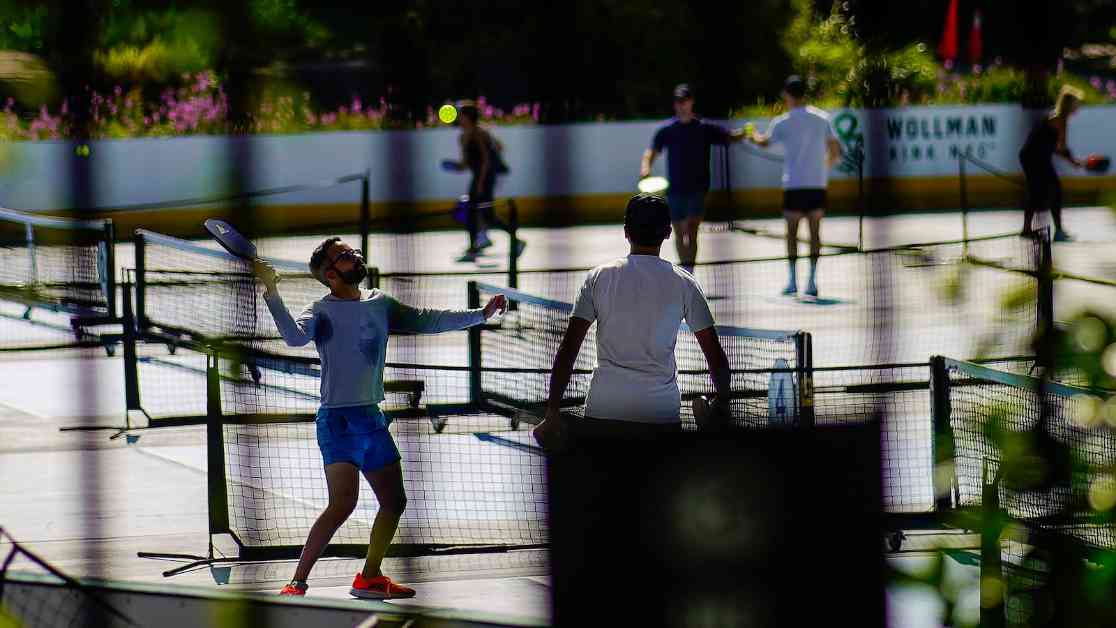The Rise of Pickleball and its Impact on American Tennis
The U.S. Open, one of the most prestigious tennis tournaments in the world, is facing an unexpected challenge – the rising popularity of pickleball. Pickleball, a sport that combines elements of tennis and ping pong using paddles and a wiffleball, has seen a remarkable surge in participation over the past few years, with a staggering 223% increase in players in the United States. This growth has raised concerns among tennis enthusiasts and officials, who fear that pickleball’s popularity could eventually surpass that of tennis.
One of the main issues raised by tennis leaders is the encroachment of pickleball on tennis infrastructure. Many tennis courts have been converted into pickleball courts, leading to tensions between the two sports’ respective communities. Dr. Brian Hainline, the President of the U.S. Tennis Association, expressed his frustration at the noise generated by pickleball matches, describing it as “obnoxious” and highlighting the impact of pickleball’s rapid growth on tennis facilities.
Differing Approaches to the Growing Popularity of Pickleball
While some tennis governing bodies in other countries have embraced pickleball as a complementary sport that could attract more players to tennis, the USTA has taken a different approach. Instead of promoting pickleball, the USTA has launched over 400 pilot programs across the country to introduce a modified version of tennis called “red ball tennis.” This beginner-friendly format uses a larger, low-compression red ball and shorter courts, making it easier for players of all ages to learn and enjoy the sport.
According to Hainline, the USTA’s goal is to encourage people to start playing tennis on shorter courts, with the hope that they will eventually transition to full-court tennis. By promoting red ball tennis on pickleball courts, the USTA aims to provide a pathway for individuals to discover and engage with tennis in a more accessible and enjoyable way.
The Evolution of Pickleball and its Growing Appeal
Despite the concerns raised by tennis officials, the pickleball community remains optimistic about the sport’s future. Mike Nealy, the CEO of Pickleball USA, acknowledges the challenges posed by tennis advocates but emphasizes the positive aspects of pickleball’s growth. With over 50,000 pickleball courts in the country and increasing investment in the sport, pickleball has become a popular choice for players of all ages and skill levels.
Nealy points out that pickleball’s accessibility and social nature have contributed to its widespread appeal. The ease of learning the game, the relatively low cost of equipment, and the opportunity for social interaction make pickleball an attractive option for many individuals looking for a fun and engaging recreational activity. Despite the competition with tennis, Nealy believes that there is room for both sports to thrive and coexist harmoniously.
The Future of Tennis and Pickleball in America
As both tennis and pickleball continue to grow in popularity, the sports industry faces the challenge of accommodating the diverse preferences of players and fans. The Sports & Fitness Industry Association’s annual survey highlights the significant growth of pickleball among younger demographics, indicating a shift in the sport’s appeal from retirees to a broader audience.
Tom Cove, the President and CEO of SFIA, emphasizes the unique qualities of pickleball that contribute to its widespread adoption. The simplicity of the game, the minimal barriers to entry, and the social aspect make pickleball an attractive option for individuals seeking a recreational activity that is both enjoyable and inclusive. With the increasing interest in pickleball among younger generations, the sport’s future looks promising.
In response to the evolving landscape of racket sports, the USTA is taking proactive steps to promote tennis and attract new players. The introduction of red ball tennis and the expansion of beginner-friendly programs aim to make tennis more accessible and appealing to a wider audience. By offering alternative formats of the sport and leveraging existing pickleball infrastructure, the USTA seeks to position tennis as a viable and engaging option for individuals looking to explore new recreational activities.
In conclusion, the rise of pickleball poses both challenges and opportunities for American tennis. While the growing popularity of pickleball may impact tennis infrastructure and player participation, it also highlights the need for innovation and adaptation within the sports industry. By embracing change, promoting inclusivity, and exploring new avenues for growth, tennis and pickleball can coexist and thrive in a dynamic and evolving sports landscape.

















